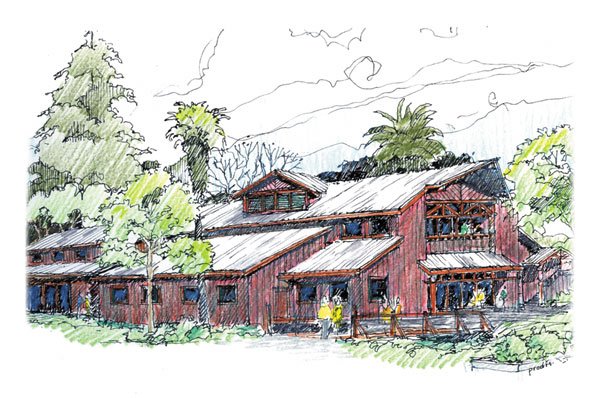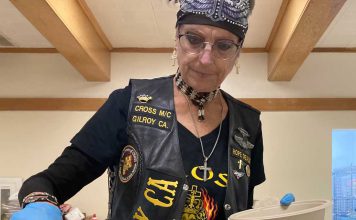Most locals are familiar with a particular red barn in Gilroy, a
once iconic bastion of pastoral Americana now neglected in
Christmas Hill Park after weathering nature’s elements for close to
a century.
Most locals are familiar with a particular red barn in Gilroy, a once iconic bastion of pastoral Americana now neglected in Christmas Hill Park after weathering nature’s elements for close to a century.
Formerly utilized for recreation and farming in the early to mid-1900s, this 5,000-square-foot structure flecked in chipped paint has become a time capsule barred behind padlocked, modern-day chain link fencing. It’s now a city-owned haven for cats, bats, rodents and birds, where the scuttling of pigeon feet on a tin roof sends scratching noises echoing through the rafters.
Can it be brought back to life, as some community members hope? Or does its life expectancy have an expiration date?
That’s the million dollar question. City Administrator Tom Haglund says the area “likely comes under the category of being deferred, but not forgotten.”
Gilroy Historical Society President Connie Rogers and fellow member Carol DeSantis say their group has been “concerned about the barn for a long time,” and would like to see it reincarnated into an educational center with an emphasis on environmental science. Rogers says she’s 95 percent sure it was built in the late 1800s for cattle baron Henry Miller, but has not been able to substantiate her belief.
“We really love that barn. A lot of people do,” said DeSantis. “The fact that it has survived; the proportions are great: The height, the width, the shape. People are just fond of it. It’s been around forever. It’s a sign of continuity from a time before I was born.”
Rogers thinks demolition isn’t the answer and believes “most people” aren’t aware the city approved plans to tear the barn down. She’d like to see a newer barn constructed that “could incorporate the original skeletal timbers in the same shape.”
City plans for the Ranch Side of Christmas Hill Park drawn up in 2006 depict an alternate vision that involves tearing the structure down.
A brand new 13,450-square-foot community center closely resembling the original design would be erected in its place, according to plans sent over by Bill Headley, City of Gilroy parks and landscape supervisor who says the new building would integrate the red planks and other wood beams leftover from its demolished predecessor. Classrooms, a kitchen and an assembly area are also in the mix.
But that vision was conjured prior to 2008-09, when Haglund points out the city dove into “very severe budget cutting mode” that caused myriad projects to be delayed.
Seeing the effort to fruition is now contingent on fiscal resources and the needs of the community, according to both Haglund and David Stubchaer, senior civil engineer, who said the city currently has no funding for the project – “so it may be irrelevant as to how much the estimate was in previous years.”
Plans list the community center as costing between $3.5 to $4.2 million, but Stubchaer delineated “when the project is revived at some point in the future, a budget would have to be established and the plans may change or be phased accordingly.”
To expedite upgrades at the Ranch Site, Haglund said it would take “significant” grant funding, assistance from special interest groups or raising the money from some alternate means.
This means the memento of agricultural history could continue on its slow path of decay for awhile – since “whether or not we’ll be able to proceed with the project out there is really probably several years off,” Haglund said.
Rogers thinks existing plans should be reevaluated and wishes the city “was not allowing demolition by neglect,” adding “there is no foundation and the walls are in bad shape, but I think the large timbers of the skeleton are solid.”
At the moment, it’s not a pressing priority for city officials who say the dilapidated structure isn’t on their radar.
Mayor Al Pinheiro and two councilmen were quick to respond, but with limited insight. The subject is clearly on the back burner. Haglund and Stubchaer also had to brush up on specifics, since plans for the community center pre-dated their current positions.
“I have not heard anything,” said Pinheiro. “A long time ago they were talking about restoring it, but I haven’t heard a word since then.”
Councilman Bob Dillon said he hasn’t overheard discussion pertaining to the barn in years, and Councilman Perry Woodward said he hasn’t viewed plans for the community center, either – but thinks the barn is an attribute to Christmas Hill’s aesthetic backdrop as “it gives kind of a flavor to that area from years ago.”
“I’m a little disappointed to know its going away,” he said. “I like it there.”
Woodward added he would like to see the barn preserved and is willing to take a “new look” at the plan, but speculated there’s probably a justifiable reason master plans have the barn scheduled to be razed.
Headley also touched on this, explaining consultants brought in years ago to examine the barn identified dry rot, issues with the roof and “lateral drift.” These issues are documented in a report dated June 12, 2004.
“It’s not a useable structure,” said Headley. “It would have to totally come down and be reconstructed.”
He emphasized a sensitivity to the barn’s cultural significance and place in agricultural history, hence the intention to salvage original materials that could be reused and assimilated into the new community center – whenever that project takes place.
Keeping the barn on the table and in public awareness is important, Headley added, albeit it’s one of dozens of projects on the city’s to-do list. He suggested a very distant possibility of putting a park bond on the ballot to see if community members would be in favor of accelerating the project with tax dollars, although Haglund said “there’s still some substantial economic recovery ahead of us before we would be in a position to consider that.”
As for other organizations tied to the antiquity, the Gilroy Historical Society hasn’t changed its position since 2006 – it wants to see the barn renovated, rather seeing an entirely new building constructed in its place.
The Garlic Festival Association is at an impasse, and sees the situation from both points of views. Up until 2004, it was allowed to keep its signs in the barn during festival off-season.
“It was a fabulous storage facility,” said Garlic Festival Executive Director Brian Bowe, “a ‘behind the scenes’ venue for us, if you will.”
Bowe called it a “great old structure” the association would love to be able to take advantage of, “but I also appreciate the huge cost of trying to renovate it.”
Reflecting on the lack of communication between the city, community and special interest groups when it comes to the lonely relic of bygone eras, DeSantis pointed out many locals “love” the barn – “there’s just no coalescence of these people.”
The city’s capital project to-do list
– Curb and gutter repair
– Repair certain sidewalks
– Repave certain streets
– Finish the new library
– Improvements to San Ysidro Park
– Lifeguard chairs for SV pool
– Repair/replace city handicap ramps at street corners
– Downtown Plaza/Paseo/Pocket Park construction
– Finish Lions Creek Trails Projects
– Gilroy Arts Center demolition
– Aquatics Center equipment
– Forest Street Park demolition
– Outdoor barbecue, fence repairs and restroom updates at Christmas Hill Park













